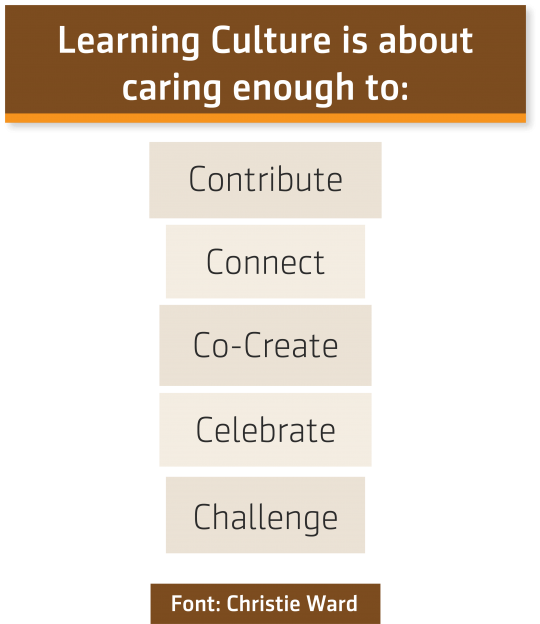I’m here with Christie Ward and we will talk about the challenges and the solutions to implement a learning culture. I’m Wagner Cassimiro and this is the Espresso3.
Why is it so difficult to implement a learning culture?
There’s a lot of things that get in the way. First of all, leaders many times don’t see the value because learning is a cost center to the organization, it’s not a profit center, so it doesn’t make money for the organization just like HR. They look at that as a kind of a necessary evil, if you will and something people maybe go to take a virtual class or do something like that and what we call check the box, but they didn’t learn anything, nothing changed.
The other piece is silos in the organizations. Organizations are so “this department does it this way, this department does it that way” and they don’t always talk to each other. A learning culture is a big concept, it’s a big picture concept. So, a lot of organizations don’t see the need because they don’t see the profit in it and they don’t realize that their people are their competitive advantage. Unless we train people, particularly with some of these soft skills like communication, conflict resolution, empathy, good listening skills, if we don’t train both the managers as well as the workers in these things we won’t have a company in another five years.
I think it’s really important to create a learning culture where it’s encouraged, where there’s a growth mindset instead of that restrictive closed mindset that we can’t change and “I need to go to this class but it’s not going to make a difference to me”. We need to train managers how to incorporate learning, how to have conversations with their employees which will sound like this: “I’m so glad you’re going to this training tomorrow. I can’t wait to hear what you learn and I want you to come back and tell me what you learned”. That’s a conversation that I can teach a manager how to do that, but they don’t do that right now.
Christie, what are your contributions and suggestions to build and develop a learning culture?
I think the learning professionals inside the organization need to lead the charge, but they need to start with leadership. Leadership needs to understand this and embrace it, it needs to be important to them and we need to win them over.
We need to be business partners with the C level people in the organization, we don’t need to be just part of HR, we need to be there when the business strategy is created to show them how we can help the employees to become more proficient and that we do play a role in the success of a company. We are not a profit center, however we play a role. But it needs to come from the top down. The leader needs to be behind it.
I need to teach the managers and give special classes for the managers, “here’s what you say to your employee before they go to class. Here’s how you talk to them after they go to class”. You don’t reprimand them for not being at work and having to do twice as much work because they were in class.
Learning needs to become a part of the organization and we need to motivate managers first to help people. I think people naturally want to learn. Everybody wants to feel smart, learn new tools. People come to work wanting to do a good job, but we don’t always let them, because we don’t always have a learning organization to support us to do that. It has to start at the top, but as learning professionals we may need to ask some difficult questions and see if we can get a seat at the table to be part of the strategic plan. That’s where it needs to start.
You a have a five “C” model to contribute with this construction. Could you explore more each one?
I can share a little bit of that with you. Absolutely!
I need to help people contribute, I need to make them feel like they have a significant part to play in the organization.
I need to help people to have what I call “healthy conflict”, challenge the status quo, ask the questions they need, ask for feedback, some of those kinds of things.
We need to co-create with our employees, we need to not just be curators of content, but we need to, as trainers, set the context for the learning and let the learners learn the content.
We need to celebrate with people when they do things right and also when they fail and they learn a lesson, that’s really important.
We need to have fun with people, we need to create an environment where they are motivated to succeed and a lot of times that doesn’t happen. People go to work and they’re not encouraged, they are not motivated and I think that getting to know employees. I had a question about that from an attendee here, “How do I get people online to be more engaged, to show more empathy?”. Well, you have to get to know them first and you have to have conversations with them. It’s an ongoing process, but you need to start with having conversations with those people so that they trust you.
In other words, don’t just start an online training and just get into content. Talk to the people that are going to take it. Find out something about them. What’s important to them? What are they looking forward to learn? And having that dialogue back and forth, that communication is critical. There’s a lot of pieces to it, but I think holistically, if we would do all those things, we would be the instigators of the learning culture of the organization.
Thank you!
You’re welcome! Thank you for having me.

For more information access: https://christieward.com
TRADUÇÃO
Estou aqui com Christie Ward e falaremos sobre os desafios e as soluções para implementar uma cultura de aprendizagem.
Eu sou Wagner Cassimiro e este é o Espresso3.
Por que é tão difícil implementar uma cultura de aprendizagem?
Há muitas coisas que atrapalham. Antes de tudo, os líderes muitas vezes não vêem o valor porque treinamento é um centro de custos para a organização, não é um centro de lucro, não gera dinheiro para a organização assim como o RH. Eles encaram isso como uma espécie de mal necessário, pode-se dizer, e algo que as pessoas talvez façam uma aula virtual ou façam algo assim e o que chamamos de marcar a caixa, mas elas não aprenderam nada, nada mudou.
A outra peça são silos nas organizações. As organizações são tão “este departamento faz assim, aquele departamento faz assim” e nem sempre conversam entre si. Uma cultura de aprendizagem é um grande conceito, é um conceito amplo. Então, muitas organizações não veem a necessidade porque não veem lucro e não percebem que suas pessoas são sua vantagem competitiva. A menos que treinemos pessoas, particularmente em algumas dessas soft skills, como comunicação, resolução de conflitos, empatia, boa capacidade de ouvir, se não treinarmos tanto os gerentes quanto os funcionários nessas coisas, não teremos uma empresa em mais cinco anos.
Eu acho que é realmente importante criar uma cultura de aprendizagem onde seja incentivada, onde exista uma mentalidade de crescimento em vez daquela mentalidade restritiva fechada que não podemos mudar e “eu preciso ir a essa aula, mas isso não fará diferença para mim”. Precisamos treinar os gerentes como incorporar a aprendizagem, como conversar com seus funcionários assim: “Estou tão feliz que você participará desse treinamento amanhã. Mal posso esperar para ouvir o que você aprendeu e quero que você volte e me conte”. É uma conversa que eu posso ensinar a um gerente como ter, mas eles não fazem isso agora.
Christie, quais são suas contribuições e sugestões para construir e desenvolver uma cultura de aprendizagem?
Eu acho que os profissionais de aprendizagem dentro da organização precisam liderar o esforço, mas precisam começar com a liderança. A liderança precisa entender isso e abraçar, precisa ser importante para eles e precisamos conquistá-los.
Precisamos ser parceiros de negócios com a diretoria na organização, não precisamos apenas fazer parte do RH, precisamos estar presentes quando a estratégia de negócios é criada para mostrar a eles como podemos ajudar os funcionários a se tornarem mais proficientes e que desempenhamos um papel no sucesso da empresa. Não somos um centro de lucro, no entanto, desempenhamos um papel. Mas precisa vir de cima para baixo. O líder precisa estar por trás disso.
Eu preciso ensinar os gerentes e dar aulas especiais para os gerentes, “é isso que você diz ao seu funcionário antes de ele ir para a aula. É assim que você fala com eles depois que eles vão para a aula”. Você não os repreende por não estarem no trabalho e terem que fazer o dobro do trabalho porque estavam na sala de aula.
A aprendizagem precisa se tornar parte da organização e precisamos motivar os gerentes primeiro a ajudar as pessoas. Eu acho que as pessoas naturalmente querem aprender. Todo mundo quer se sentir inteligente, aprender novas ferramentas. As pessoas vêm para o trabalho querendo fazer um bom trabalho, mas nem sempre as deixamos, porque nem sempre temos uma organização de aprendizagem para nos ajudar a fazer isso. Precisa começar do topo, mas, como profissionais da área de aprendizagem, talvez seja necessário fazer algumas perguntas difíceis e ver se conseguimos sentar à mesa para fazer parte do plano estratégico. É aí que precisa começar.
Você tem um modelo de cinco “C” para contribuir com essa construção. Você poderia explorar mais cada um?
Eu posso compartilhar um pouco disso com você. Sem dúvida!
Preciso ajudar as pessoas a contribuir, preciso fazê-las sentir que têm um papel importante a desempenhar na organização.
Preciso ajudar as pessoas a ter o que chamo de “conflito saudável”, desafiar o status quo, fazer as perguntas de que precisam, pedir feedback, esse tipo de coisas.
Precisamos co-criar com nossos funcionários, precisamos não apenas ser curadores de conteúdo, mas precisamos, como treinadores, definir o contexto da aprendizagem e permitir que os alunos aprendam o conteúdo.
Precisamos celebrar com as pessoas quando elas fazem as coisas certas e também quando elas falham e aprendem uma lição, isso é realmente importante.
Precisamos nos divertir com as pessoas, precisamos criar um ambiente em que elas sejam motivadas para ter sucesso e muitas vezes isso não acontece. As pessoas vão para o trabalho e não são incentivadas, não são motivadas e acho que conhecer os funcionários. Eu tive uma pergunta sobre isso de um participante aqui: “Como faço para que as pessoas online para se envolverem mais, mostrarem mais empatia?”. Bem, você precisa conhecê-los primeiro e conversar com eles. É um processo contínuo, mas você precisa começar conversando com essas pessoas para que elas confiem em você.
Em outras palavras, não basta iniciar um treinamento on-line e apenas entrar no conteúdo. Converse com as pessoas que vão fazer. Descubra algo sobre eles. O que é importante para eles? O que eles estão ansiosos para aprender? E ter esse diálogo, essa comunicação é crítico. Há muitas peças para isso, mas holisticamente, se fizéssemos todas essas coisas, seríamos os instigadores da cultura de aprendizado da organização.
Obrigado!
De nada! Obrigada por me convidar.

Para mais informações acesse: https://christieward.com
